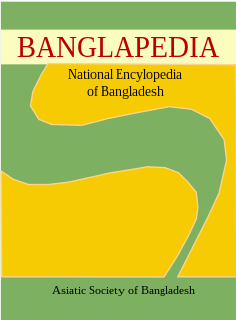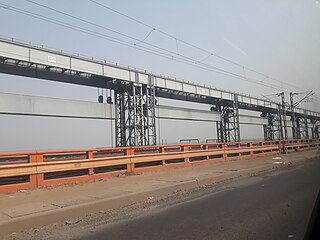
Dhaka, formerly known as Dacca, is the capital and the largest city of Bangladesh, as well as the largest city in the Bengal region. It is the eighth-largest and the fourth-most densely populous city in the world with, as of 2011, a population of 8.9 million residents within the city limits, and a population of over 21.7 million residents in the Greater Dhaka Area. Dhaka is the economic, political, and cultural center of Bangladesh, and is one of the major cities in South Asia, the largest city in Eastern South Asia and among the Bay of Bengal countries; and one of the largest cities among OIC countries. As part of the Bengal plain, the city is bounded by the Buriganga River, Turag River, Dhaleshwari River and Shitalakshya River.

Banglapedia:theNational Encyclopedia of Bangladesh is the first Bangladeshi encyclopedia. It is available in print, CD-ROM format and online, in both Bengali and English. The print version comprises ten 500-page volumes. The first edition was published in January 2003 by the Asiatic Society of Bangladesh, with a plan to update it every two years. The second edition was issued in 2012.

Sonargaon is a historic city in central Bangladesh. It corresponds to the Sonargaon Upazila of Narayanganj District in Dhaka Division.

Narayanganj District is a district in central Bangladesh which is a part of the Dhaka Division. It is home to the ancient city of Sonargaon and is one of the oldest industrial districts in the country. The district lies on the banks of the Shitalakshya River and the Meghna River. It is an industrial hub and plays an important part in the country's jute trade, plant processing and sector. It is nicknamed the "Dundee of Bangladesh" due to the presence of many jute mills.

Brahmanbaria is a district in eastern Bangladesh located in the Chittagong Division. Geographically, it is mostly farmland and is topographically part of the Gangetic Plain. It is bounded by the districts of Kishoreganj and Habiganj to the north, Narsingdi District and Narayanganj to the west, Comilla to the south, and the Indian state of Tripura to its east.

Sirajul Islam is Bangladeshi historian, writer, columnist, professor and academician. He is the chairman of the Board of Editors of Banglapedia, the national encyclopedia of Bangladesh, and the editor of the Journal of the Asiatic Society of Bangladesh. He is also famous for his works on agriculture, British era land tenure and social history of Bengal.

The Nawab of Bengal was the hereditary ruler of Bengal Subah in Mughal India. The Nawab of a princely state or autonomous province is comparable to the European title of Grand Duke. In the early 18th-century, the Nawab of Bengal was the de facto independent ruler of the three regions of Bengal, Bihar, and Orissa which constitute the modern-day sovereign country of Bangladesh and the Indian states of West Bengal, Bihar and Orissa. They are often referred to as the Nawab of Bengal, Bihar and Orissa. The Nawabs were based in Murshidabad which was centrally located within Bengal, Bihar, and Orissa. Their chief, a former prime minister, became the first Nawab. The Nawabs continued to issue coins in the name of the Mughal Emperor. But for all practical purposes, the Nawabs governed as independent monarchs. Bengal continued to contribute the largest share of funds to the imperial treasury in Delhi. The Nawabs, backed by bankers such as the Jagat Seth, became the financial backbone of the Mughal court. During the 18th-century, the Nawabs of Bengal were among the wealthiest rulers in the world.

The Bengali people, also known as Bangalee, are an Indo-Aryan ethnolinguistic group originating from and culturally affiliated with the Bengal region of South Asia. The native population is divided between the independent country Bangladesh and the Indian states of West Bengal, Tripura, Assam's Barak Valley and parts of Manipur. Most of them speak Bengali, a language from the Indo-Aryan language family.

Dhaka District is a district in central Bangladesh, and is the densest district in the nation. It is a part of the Dhaka Division. Dhaka, the capital of Bangladesh, and rests on the eastern banks of the Buriganga River which flows from the Turag to the southern part of the district. While Dhaka occupies only about a fifth of the area of Dhaka district, it is the economic, political and cultural centre of the district and the country as a whole. Dhaka District consists with Dhaka, Keraniganj, Nababganj, Dohar, Savar and Dhamrai upazila. Dhaka District is an administrative entity, and like many other cities it does not cover the modern conurbation which is Greater Dhaka, which has spilled into neighbouring districts, nor does the conurbation cover the whole district, as there are rural areas within the district.

Farakka Barrage is a barrage across the Ganga river located in Murshidabad district in the Indian state of West Bengal, roughly 18 kilometres (11 mi) from the border with Bangladesh near Shibganj. Farakka Barrage Township is located in Farakka in Murshidabad district. Construction of the Farakka barrage started in 1962, was completed in 1970 at a cost of $208 million. Operations began on 21 April 1975. The barrage is about 2,304 metres (7,559 ft) long. The Feeder Canal (Farakka) from the barrage to the Bhagirathi-Hooghly River is about 42 km (26 mi) long.

Dacca or Dhaka is the capital and one of the oldest cities of Bangladesh. The history of Dhaka begins with the existence of urbanised settlements in the area that is now Dhaka dating from the 7th century CE. The city area was ruled by the Buddhist and shaivite Pala Empire before passing to the control of the Sena dynasty in the 10th century CE. After the Sena dynasty, Dhaka was successively ruled by the Turkic and Afghan governors descending from the Delhi Sultanate, followed by the Bengal Sultanate, before the arrival of the Mughals in 1608. The city became proto-industrialised and declared capital of the Mughal Bengal. After Mughals, British ruled the region for 200 years until the independence of India. In 1947, Dhaka became the capital of the East Bengal province under the Dominion of Pakistan. After the independence of Bangladesh in 1971, Dhaka became the capital of the new state.

Mirza Abu Talib, better known as Shaista Khan was a general and the subahdar of Mughal Bengal. A maternal uncle to the emperor Aurangzeb, he acted as a key figure during his reign. Shaista Khan initially governed the Deccan, where he clashed with the Maratha ruler Shivaji. However, he was most notable for his tenure as the governor of Bengal from 1664 to 1688. Under Shaista Khan's authority, the city of Dhaka and Mughal power in the province attained its greatest heights. His achievements include constructions of notable mosques such as the Sat Gambuj Mosque and masterminding the conquest of Chittagong. Shaista Khan was also responsible for sparking the outbreak of the Anglo-Mughal War with the English East India Company.

Nawab Sir Khwaja Salimullah Bahadur was the fourth Nawab of Dhaka and one of the leading Muslim politicians during the British rule in India. In 1906, the Muslim League was officially founded at the educational conference held in Dhaka. The convention was held at Ahsan Manzil, the official residence of the Dhaka Nawab Family. Sir Salimullah was a key patron of education for the Eastern Bengal. He was one of the founders of the University of Dhaka and the prestigious Ahsanullah School of Engineering. Sir Salimullah was a staunch supporter of the Partition of Bengal and was a member of East Bengal and Assam Legislative Council from 1906 to 1907. He was also a member of Bengal Legislative Assembly from 1913 till his death in Calcutta in 1915 at the age of 43. He was the founder President of Bengal Muslim League in 1907.

Sarail is an upazila of Brahmanbaria District located in the Chittagong Division and near the Dhaka Division, Bangladesh.

Kapasia is an upazila (sub-district) of Gazipur District in central Bangladesh, part of the Dhaka Division. It is located at 24.1000°N 90.5708°E, and is best known as the home upazila of Tajuddin Ahmad, the first Prime Minister of Bangladesh. The modern-day upazila was a part of the historic Bhawal Estate and falls within its boundary.

The national language and official language of Bangladesh is Bengali according to the third article of the Constitution of Bangladesh. And the second most spoken language in Bangladesh is claimed to be Burmese (မြန်မာ) which is spoken by the Marma tribe in chittagong hill districts as the distrcts border Myanmar and it's also spoken by the Rohingya people.98% of Bangladeshis are fluent in Bengali as their first language. Bengali Language Implementation Act, 1987 made it mandatory to use Bengali in all government affairs except in the cases of foreign relations. According to a 2011 census, Bengali is predominantly spoken by 98% of the country's population and it also serves as the national language of the nation. The indigenous people of northern and southeastern Bangladesh speak a variety of native languages.

Bakarkhani or Baqarkhani, also known as bakar khani roti, is a thick, spiced flat-bread that is part of the Mughlai cuisine. Bakarkhani is prepared on certain Muslim religious festivals and is now popular as sweet bread.

The Armenians in Bangladesh were ethnic Armenians who lived in what is now called Bangladesh. Their numbers have gradually diminished and there are now no Armenians in the country.

Old Dhaka is a term used to refer to the historic old city of Dhaka, the capital of Bangladesh. It was founded in 1608 as Jahangirabad or Jahangirnagar, the capital of Mughal Province of Bengal and named after the Mughal emperor Jahangir. It is located on the banks of the Buriganga River. It was one of the largest and most prosperous cities of South Asia and the center of the worldwide muslin trade. The then Nawab of Bengal Murshid Quli Khan shifted the capital from Dhaka to Murshidabad in the early-18th century. With the rise of Calcutta during the British rule, Dhaka began to decline and came to be known as the "City of Magnificent Ruins". The British however began to develop the modern city from the mid-19th century.

Bengali Muslims are adherents of Islam who ethnically, linguistically and genealogically identify as Bengalis. They are the second largest Muslim ethnic group in the world and the largest among the Indo-Europeans. Bengali Muslims make up the majority of Bangladesh's citizens, and are the largest minority in the Indian states of West Bengal, Assam and Tripura. They speak or identify the Bengali language as their mother tongue. The majority of Bengali Muslims are Sunnis who follow the Hanafi school of jurisprudence.


















